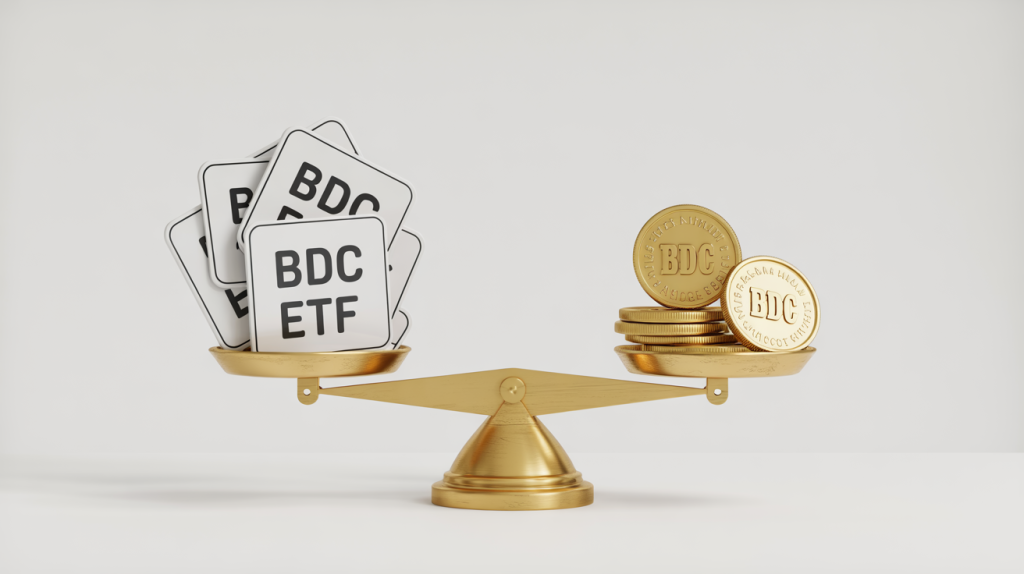
One Basket or a Few Carefully Chosen Eggs?
BDC investing can appear deceptively straightforward, and that’s exactly where many investors misstep. Exchange-traded funds (ETFs) promise diversification, ease of use, and a quick route to yield generation. For the time-starved investor, they seem like the perfect plug-and-play solution. But as every serious value investor knows, convenience can come at the cost of returns, control, and long-term compounding. The real question isn’t whether ETFs are good or bad—it’s whether they align with your investment philosophy and goals.
So ask yourself: how much control do you want over what you own? Are you satisfied holding a basket of the good, the bad, and the ugly in equal proportion? Or do you want to own only the best-managed BDCs with disciplined underwriting and a long runway for NAV growth? This article breaks down the trade-offs between owning BDC ETFs like BIZD versus handpicking your own Business Development Companies. The answer isn’t always obvious. It depends on your approach, your tolerance for short-term volatility, and your commitment to long-term compounding.
BDC ETFs Like BIZD: A One-Click Diversified Yield Machine
The VanEck BDC Income ETF (ticker: BIZD) is the most well-known BDC ETF on the market. It gives you immediate exposure to dozens of BDCs in one trade, with automatic rebalancing and monthly income distributions. For investors looking to add high-yield exposure without researching each BDC individually, BIZD is an attractive option.
It also helps investors bypass the liquidity issues sometimes associated with smaller BDCs. When you buy BIZD, you’re tapping into a pool of companies that lend to middle-market businesses—many of which are privately held and would be hard to access otherwise. These BDCs provide capital where traditional banks often won’t, and they do so with yields that make REITs look modest.
But ease and access can mask a deeper issue.
What You Gain, and What You Give Up
BDC ETFs like BIZD do a lot of things well. They give you a broadly diversified basket across the BDC universe, which lowers the risk that any single implosion tanks your portfolio. They distribute income regularly, typically on a monthly or quarterly basis. And they offer the kind of liquidity and simplicity that allows you to set and forget your investment.
BIZD has a headline expense ratio of just 0.4%, which is modest by ETF standards. However, it’s important to understand that the underlying BDCs themselves also charge fees—an average of about 12.9% of net investment income. These internal costs are baked into the returns you receive, whether you own them through an ETF or directly. In other words, buying individual BDCs doesn’t avoid this embedded fee structure. You’re paying for active credit management either way.
What you do give up with BIZD is selectivity. The ETF uses a market-cap weighted approach, which often leads to outsized allocations in the largest BDCs—not necessarily the best ones. It also means that when a BDC becomes overvalued, BIZD might be forced to allocate more capital to it, not less. That’s the opposite of what a disciplined investor would want to do.
You also miss the chance to exploit inefficiencies. Individual BDCs often trade below NAV or respond to market dislocations in ways that can be exploited by savvy investors. An ETF rebalancing based on index criteria won’t take advantage of those opportunities.
Why Active Selection of BDCs Might Outperform
The performance dispersion between BDCs is wide. Some have stellar management teams, low non-accrual rates, conservative leverage, and NAVs that trend steadily upward. Others pursue aggressive strategies, take on questionable credits, and erode shareholder value through dilutions or secondary offerings.
When you own the entire sector through an ETF, you’re exposed to both ends of the spectrum. That includes the value creators and the capital destroyers. Your returns get diluted by poor capital allocation decisions made by weaker BDCs. In contrast, if you identify the top-tier operators—those with proven underwriting discipline, aligned incentives, and strong risk controls—you can stack the odds in your favor.
Active selection also gives you more precise control over your income stream. Some BDCs over-distribute to maintain yield, while others retain earnings to build NAV. Depending on your goals—income now vs. growth later—you can tilt your portfolio to match your needs. That’s impossible with a one-size-fits-all ETF.
The Real Power: Reinvesting in Undervalued BDCs
One of the most overlooked advantages of owning individual BDCs is the ability to compound intelligently. Say you buy a high-quality BDC trading at a 20% discount to NAV, yielding 10%. Every dollar reinvested while the stock remains undervalued increases your effective return. Not only are you collecting high yields, but you’re also acquiring more of the same asset at a discount. Over time, this accelerates the compounding flywheel.
In contrast, an ETF like BIZD doesn’t allocate based on valuation. It rebalances based on market cap and index rules, which means it might trim a BDC trading below NAV just because its market cap fell, and add to an overvalued name that recently ran up. It’s a momentum-following mechanism that leaves little room for intelligent capital allocation.
Reinvestment decisions in a personal BDC portfolio become part of your strategy. You can overweight temporarily depressed names or trim exposure to those that are fully valued. It’s not just about riding the wave—it’s about directing your capital to where it can work the hardest.
So, What’s the Smarter Way to Invest?
The answer depends on you.
If you want simplicity, liquidity, and exposure to the yield offered by the BDC sector, BDC ETFs like BIZD do the job. They provide decent income with minimal effort, and for many investors, that’s enough. But understand that you’re giving up control, potential upside, and the ability to sidestep underperformers.
If your goal is to beat the market—or at least do better than average—then actively selecting BDCs is likely the better path. You’ll need to do more work upfront, but the reward is the opportunity to build a more efficient, better-valued portfolio with a higher margin of safety.
A hybrid approach also works. Start with a position in BIZD to gain exposure and monthly income. Then, as you study the space and develop a feel for which BDCs are consistently outperforming, rotate out of the ETF and into individual names. Over time, you’ll build confidence and control.
Control, Compounding, and Commitment
Ultimately, your vehicle should reflect your philosophy. If you believe in buying dollar bills for fifty cents, avoiding the permanent loss of capital, and letting intelligent capital allocation do the heavy lifting, then ETFs will feel like a compromise.
But if you simply want high yield, low effort, and broad sector exposure, there’s nothing wrong with starting with an ETF. Just go in with open eyes.
If you want help identifying which BDCs offer deep value today, subscribe to the premium research. I highlight select names trading below NAV, with management teams that are shareholder-friendly and balance sheets that can weather credit cycles. These are the building blocks of a portfolio that doesn’t just pay income—it builds wealth.
Because in the end, it’s not about whether you pick a BDC ETF or individual BDCs. It’s about whether your capital is working as hard as it could be.

Shailesh Kumar, MBA is the founder of Astute Investor’s Calculus, where he shares high-conviction small-cap value ideas, stock reports, and investing strategies.
His work has been featured in the New York Times and profiled on Wikipedia. He previously ran Value Stock Guide, one of the earliest value investing platforms online.
Subscribe to the Inner Circle to access premium stock reports and strategy insights.
Featured in:



